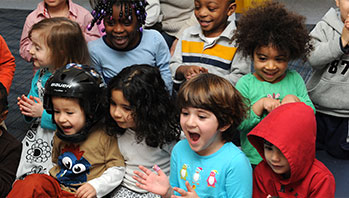- drums
- rubber band instruments
- toy instruments
- tappers
- high
- instrument
- low
- sound
MA Standards:
Speaking and Listening: SL.PK.MA.1a Observe and use appropriate ways of interacting in a group (e.g., taking turns in talking, listening to peers, waiting to speak until another person is finished talking, asking questions and waiting for an answer, gaining the floor in appropriate ways).
Head Start Outcomes:
Social Emotional Development/Self-Regulation Follows simple rules, routines, and directions.
Language Development/Receptive Language Attends to language during conversations, songs, stories, or other learning experiences.
PreK Learning Guidelines:
English Language Arts/Language 1 Observe and use appropriate ways of interacting in a group (taking turns in talking; listening to peers; waiting until someone is finished; asking questions and waiting for an answer; gaining the floor in appropriate ways).
English Language Arts/Reading and Literature 12 Listen to, recite, sing, and dramatize a variety of age-appropriate literature.
EEC Infant and Toddler Guidelines:
PW50. The older toddler engages in a variety of physical activities.
Greeting Song: “Show Us Something You Can Do” #3

© Commonwealth of Massachusetts, Department of Early Education and Care (Jennifer Waddell photographer). All rights reserved.
STEM Key Concepts: Different objects make different sounds; Sounds vary in three ways: volume (loud or soft), pitch (high or low), and timbre (quality)
ELA Focus Skills: Phonological Awareness (Rhyme, Repetition), Creative Expression, Listening and Speaking, Name Recognition
Sing “Show Us Something You Can Do” with children. Sing the song once to demonstrate. Then sing the song again and point to a child as you hold up his or her name card and say, If you can recognize your name, show us something you can do with your instrument.
- Ask children to describe the sounds they are going to make with their instruments, such as, I can make a growly, low sound. I can make a fast, squeaky sound.
- Then ask the rest of the group, How does that high sound make you feel? How does it make you want to move? Encourage children to move, sway, and dance to the sounds.
Show Us Something You Can Do
Hello, <child’s name>. How are you?
Show us something you can do.
(child performs motion)
This is what <child’s name> can do.
We can all do it, too.
(children copy motion)
